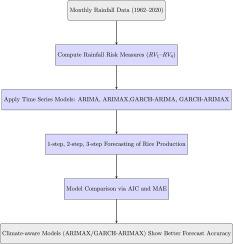量化雨养农业中降雨引起的气候风险:来自半干旱印度的基于波动率的时间序列研究
IF 6.5
1区 农林科学
Q1 AGRONOMY
引用次数: 0
摘要
降雨量的年内变化给农业产出带来了重大挑战,特别是在半干旱季风地区。在这项研究中,我们提出了一个平均波动率时间序列建模框架,以研究降雨风险如何影响印度马哈拉施特拉邦的水稻产量预测。我们构建了四种不同的测量方法来捕捉季节性降雨变化,并将其纳入使用该州60年月度降雨数据(1962-2021)的预测模型。这些措施被纳入ARIMAX和GARCH-ARIMAX规范,以共同评估降雨波动性对产量均值和变率的影响。我们的研究结果表明,与简单的ARIMAX或iGARCH配置相比,基于波动率的模型——尤其是指数GARCH (eGARCH)和使用高阶、基于一阶差分的度量(RV3和RV4)的gjrGARCH变体——始终提供卓越的预测准确性和更强的鲁棒性。依赖于同期降雨波动的模型优于使用滞后测量的模型,强调了季节性气候异常的直接影响。在±10%扰动下对降雨风险度量的敏感性分析进一步证实,garch型模型不仅提高了预测技能,而且在合理的输入变化下增强了稳定性,使其在气候敏感型作物预测中不可或缺。这些发现表明,有必要将动态气象风险指标纳入农业预测框架,以加强预警系统,支持适应性政策设计,并在依赖季风的地区促进有抵御力的可持续种植制度。本文章由计算机程序翻译,如有差异,请以英文原文为准。

Quantifying rainfall-induced climate risk in rainfed agriculture: A volatility-based time series study from semi-arid India
Intra-annual variation in rainfall creates significant challenges for agricultural output, particularly in semi-arid monsoon regions. In this study, we present a volatility-in-mean time series modeling framework to examine how rainfall risk influences rice yield forecasts in Maharashtra, India. We construct four distinct measures to capture intra-seasonal rainfall variability and incorporate them into forecasting models using six decades of monthly rainfall data (1962–2021) for the state. These measures are embedded within ARIMAX and GARCH-ARIMAX specifications to jointly assess the effects of rainfall volatility on the mean and variability of yields. Our results show that volatility-based models – especially exponential GARCH (eGARCH) and gjrGARCH variants using higher-order, first-difference-based measures ( and ) – consistently deliver superior forecast accuracy and greater robustness compared to simpler ARIMAX or iGARCH configurations. Models relying on contemporaneous rainfall volatility outperform those using lagged measures, underscoring the immediate impact of seasonal climate anomalies. Sensitivity analysis with % perturbations to rainfall risk measures further confirms that GARCH-type models not only improve predictive skill but also enhance stability under plausible input variations, making their inclusion effectively indispensable for climate-sensitive crop forecasting. These findings reinforce the need to embed dynamic meteorological risk indicators in agricultural forecasting frameworks to strengthen early warning systems, support adaptive policy design, and promote resilient, sustainable cropping systems in monsoon-dependent regions.
求助全文
通过发布文献求助,成功后即可免费获取论文全文。
去求助
来源期刊

Agricultural Water Management
农林科学-农艺学
CiteScore
12.10
自引率
14.90%
发文量
648
审稿时长
4.9 months
期刊介绍:
Agricultural Water Management publishes papers of international significance relating to the science, economics, and policy of agricultural water management. In all cases, manuscripts must address implications and provide insight regarding agricultural water management.
 求助内容:
求助内容: 应助结果提醒方式:
应助结果提醒方式:


